Ficus Benjamina losing all leaves! Help!
Hello... I have an indoor fig tree (Ficus Benjamina) that has suddenly begun to lose its lower leaves. They turn yellow first and then fall off. I am afraid the entire tree will be bare soon; can anyone offer me advice on what to do? I have not changed anything in the tree's environment or watering -- this is a rather sudden occurrence. Please help me save my little tree -- thank you in advance! Gratefully, Lindsey
Comments (61)
gorgi
15 years agolast modified: 9 years agoThere is a big difference between mammals and plants!
Mammals have a mouth (that can drink more water),
plants have only roots; and the water-absorption
mechanism may be thoroughly disrupted by the presence
of excessive salts (and other stuff).tapla (mid-Michigan, USDA z5b-6a)
15 years agolast modified: 9 years agoWe're actually talking about the process of osmosis. Water movement across membranes, in and out of either plant or animal cells is remarkably the same. Think of seawater as compared to fertilizer solution. Men lost at sea rapidly become horribly dehydrated when, in desperation, they begin drinking seawater to satisfy thirst. The rapid dehydration is caused by the same process of reverse osmosis that cures ham/bacon. As the water is drawn from plant cells, the plasma attached to cell membranes is torn loose and the cell destroyed - thus the term 'plasmolysis' or commonly - fertilizer burn.
When we eat something salty, it increases the level of solutes in the fluid between cells (inter-cellular fluids). These extra solutes makes it more difficult for cells to gain water, and in the case of the lost sailors drinking seawater, can even pull water from human cells while we're living. The sensation of thirst is usually our signal that we need to dilute the inter-cellular solution (by drinking a fluid low in unnecessary solutes) to make it easier for our cells to absorb water.
Al
Related Professionals
Essex Landscape Architects & Landscape Designers · Dedham Landscape Contractors · Goodlettsville Landscape Contractors · Melrose Park Landscape Contractors · Webster Groves Landscape Contractors · Yuba City Landscape Contractors · Hueytown Landscape Contractors · Cary Decks, Patios & Outdoor Enclosures · Champaign Decks, Patios & Outdoor Enclosures · Hampton Bays Decks, Patios & Outdoor Enclosures · Laguna Hills Fence Contractors · Olive Branch Fence Contractors · Simi Valley Fence Contractors · West Covina Fence Contractors · Centerville Stone, Pavers & Concretedgmarie
15 years agolast modified: 9 years agoPerhaps this is simply the annual leaf drop experienced by ficus when winter comes and light levels change? The OP never says how long she owned the plant, just that the leaves are falling off.
My ficus my first year really scared me when come December-January it began turning yellow in the inside and dropping leaves--lots of them--probably over a hundred (this is a big tree-over 10' now). I freaked out the first year. This year I realized that nothing is wrong. This is what it does. In fact, it is still making new leaves on the tips. It's healthy, just a little thin, but by no means scraggly or bare, and if this year is like the last, it will bush out come spring when the sun is stronger. Last summer and fall it was full to the hilt with leaves and I expect all things being equal, it will do the same.
tapla (mid-Michigan, USDA z5b-6a)
15 years agolast modified: 9 years agoI don't think leaves would suddenly start dropping off after nearly 2 months of increasing photo-period (Dec 21-Feb 10) because of light levels that are too low. She said she fertilizes every 1-2 months; from that we can draw the conclusion she's had the plant a while.
I think the leaf loss is more likely caused by the fact that she admittedly waters in sips. This guarantees a salt build-up in soils that usually becomes more concentrated and manifest as winter progresses. Since we can water profusely to the point of free drainage from the drain holes when the plant is growing robustly, and with little worry about the possibility of root rot setting in, we are normally flushing the soil of these salts in summer. The effect of accumulating soluble salts in the soil is to make it increasingly difficult for the plant to absorb water. This reduces photosynthesis which reduces auxin production. Since a steady flow of auxin across the leaf abscission zone is required to keep an abscission layer from forming at the base of each petiole, the abscission layer forms and leaves fall - starting with the oldest. This is the basic physiology of the drought response, which can be brought on by high levels of soluble salts in the soil, under-watering, or over-watering.
Al
gonebananas_gw
15 years agolast modified: 9 years agoI have to laugh (though sympathetically) at the F. benjamina concerns. When my elderly parents lived in southern Florida and I would visit during the year and help with the heavy tasks I would have to take about 40 feet of diameter and 20 feet of height off of this front yard tree every two years or so. And this tree received nothing in care, though perhaps the yard got fertilized a bit. Shabby developers down there long ago would bulldoze every native tree, build the house, and plant a rooted cutting F. benjamina in the middle of the front yard as a fast growing no-care shade tree. That is no care until they got big, then a lot of work. Some down there in parks where they would allow the aerial roots to stay and form additional trunks got to be gigantic in width.
brendacj
13 years agolast modified: 9 years agoI recently re-potted my Ficus tree, which was severely root bound. The tree had been doing well previously (losing leaves in the fall as described above, turning yellow and dropping). I have not changed my watering habits nor the tree placement but now 3 weeks following re-potting the tree is dropping green leaves copiously. The soil is not dry and not over wet, just damp.
The potting soil I used is by Schultz and contains 0.08-0.12-0.08 fertilizer.
Can you help me pin-point the cause of the leave dropping, I am concerned.
Thanks.tapla (mid-Michigan, USDA z5b-6a)
13 years agolast modified: 9 years agoWhere do you live? Did you actually repot, which includes soil removal and root pruning, or just pot up? I take it you've added no additional fertilizer?
Al
delboy_88
13 years agolast modified: 9 years agoI have had a 7 foot tree for about 6 months. I have moved home in the last 2. Since moving the tree looses leaves every day. I notice a white fluff on the leaves sometimes, even on the branches; could this be something to do with the leaf loss? The leaves seem sticky too. The tree has less light than before, but not drastically. I fertilized two weeks ago due to the leave loss, with slow release fertilizer. I have removed them since reading somewhere that fertilizing has a negative effect if the tree is loosing leaves. New shoots seem to be dying.
It is a 'lollipop' tree. How can I stop the white fluff? I believe it to be mold..?
And help it recover?tapla (mid-Michigan, USDA z5b-6a)
13 years agolast modified: 9 years agoThe white 'fluff' is almost assuredly a mealybug infestation. I can help you with the rest, but I'm @ work now & need to attend to a commitment. I'll ttyl, or maybe someone else will chime in.
Al
tapla (mid-Michigan, USDA z5b-6a)
13 years agolast modified: 9 years agoFicus b often responds to a decrease in light levels by throwing its leaves at you; but it also sheds leaves as a drought response, which can come as an end result of a high level of soluble salts in the soil (why TDS/EC levels and ratios are important), under-watering, or over-watering.
Fertilizing isn't a bad thing in itself, even if the plant is losing leaves, but fertilizing when soluble salt levels are already high or when there are ample amounts of nutrients already in the soil is assuredly not a good thing.
Let me know if you're still around and if you want to chase this further .... the last guy was something of a will-o'-the-wisp and I don't want to be talking to dead air. ;o)
tapla (mid-Michigan, USDA z5b-6a)
13 years agolast modified: 9 years agoFicus b often responds to a decrease in light levels by throwing its leaves at you; but it also sheds leaves as a drought response, which can come as an end result of a high level of soluble salts in the soil (why TDS/EC levels and ratios are important), under-watering, or over-watering.
Fertilizing isn't a bad thing in itself, even if the plant is losing leaves, but fertilizing when soluble salt levels are already high or when there are ample amounts of nutrients already in the soil is assuredly not a good thing.
Let me know if you're still around and if you want to chase this further .... the last guy was something of a will-o'-the-wisp and I don't want to be talking to dead air. ;o)
Al
delboy_88
13 years agolast modified: 9 years agoHi,
Ok,
So if I have mealybug what do you recommend? Spraying with soapy water? The white fluff isn't obvious; I have to search for it usually. Could the mealybug be responsible for the great loss of leaves? Or is it the salt? How do I combat the salt problem? I water the plant once a weak, about 2 litres.tapla (mid-Michigan, USDA z5b-6a)
13 years agolast modified: 9 years agoIf the mealybug infestation isn't bad, you can use a q-tip soaked in rubbing alcohol to do them in. Just dab them and it will kill them. If you want something stronger, contact me off forum and I'll recommend something.
You probably have a situation where the salts have accumulated in the soil (high TDS/EC) and are preventing water uptake. I think you should flush the soil immediately:
* Late in the day, move the plant to a spot where you can fully saturate the soil. Saturate it with room temp water & allow the plant to rest for a half hour or so. This allows the salt in the soil to dissolve into the soil solution.
* Flush the soil thoroughly by pouring a volume of room temp water roughly equal to to the volume of the container through the soil. Do this at least 4-6 times, more is better.
* Depot the plant after it stops draining, and set it on newspaper overnight (skip this part if it is very root-bound). This will pull water reluctant to drain from the soil and prevent root rot if the soil is too heavy.
* In the AM, return the pot to the container (This part would be skipped too, if the plant did not remain unpotted overnight.) and fertilize with a 1/4 strength solution of a 3:1:2 (preferred) ratio fertilizer. Ask about fertilizer ratios vs %s if you don't understand.
* Keep it warm (65-80*) and give it the best light you can manage. Water carefully. If you need more help on fertilizing and watering technique, let me know.
* When the plant begins to move into the more robust part of its annual growth cycle and has gained some energy reserves, we can get after the roots/repotting, which is probably going to be something to address later in getting the plant back on track.
"To every thing there is a season, and a time to every purpose under the heaven." ;o)
Al
delboy_88
13 years agolast modified: 9 years agoThanks for that.
I think I have got rid of the mealybug with 2 heavy sprays of insecticide.
The tree has a lot less leaves, but I have noticed a couple of new leaves.
I would prefer not to take the plant out of the pot, then re-pot; would it be sufficient to just rinse through with the room temperature water a couple of times then leave to do its thing?tapla (mid-Michigan, USDA z5b-6a)
13 years agolast modified: 9 years agoFlushing the soil will help some, and for a little while, but the plant will continue to slowly decline unless you decide to do the root work. Your plant - your call.
Al
delboy_88
13 years agolast modified: 9 years agoThe mealybug has gone, but there is still a kind of sap on some leaves appearing.
The reason I am reluctant to depot the plant is because it is in a large pot and would not be too easy. Thus I would prefer a method that would be easier on the back etc. As I said, there seems to be new growth, but some tips seem to be a little dry. I'm guessing from what you said that this is due to a lack of water intake due to salt build up around the roots. How exactly does the salt build up? Only from over & under watering??tapla (mid-Michigan, USDA z5b-6a)
13 years agolast modified: 9 years agoSalt accumulates when you don't water so the entire soil mass becomes saturated and a good % of the water you apply exits the container. When you water in small sips, ALL the salts in both fertilizer and tap water remain in your soil. The accumulative affect is the same as when you rub curing salt onto ham or bacon. It pulls the moisture OUT of cells. The natural osmotic flow of water is from the soil solution into cells because there is a higher concentration of certain solutes inside of cells than in the soil solution. Whenever the soil solution contains a higher concentration of these solutes than is found inside of the solution in cells, it actually PULLS water out of cells. If this is severe enough, not only does the plant suffer drought stress, even in a sea of plenty, but also the plasma membrane pulls away from the more rigid cell walls, destroying the cells. The term for this is 'plasmolysis', but we commonly call it fertilizer burn, and it can occur with you never having fertilized - only from the accumulation of dissolved solids in tap water. Fertilizer just makes it happen faster, when you're not watering properly - or CAN'T, because of a heavy soil. Also, and for obvious reasons, using fertilizers with ratios skewed, when compared to the ratios plants actually use, can contribute significantly to the build-up of salts in the soil.
Al
delboy_88
13 years agolast modified: 9 years agoOk, so my last post was due to being lazy and busy.
I have just rinsed through about 8 times, pulled the plant from the pot and set it on newspaper... for about 8-10 hours? I also put a towel around the roots to keep them warm (?)
In short, I really don't want to kill this plant, I've killed too many things of late (not through choice-long story) so I wish to work towards life now, as you can imagine.
When I re-pot should I use totally new soil? Drainage stones in the bottom of the pot also right.
And yes, I would like a suggestion of good fertilizer, maybe you could email me the suggestions? Do you sell them directly?
And how much should I water the plant, only when it is dry? -that can be hard to tell most times. When I bought the plant the sales woman told me to water once a week with about 8 glasses of water. We spoke different languages (literally) so the communication was difficult.
My apartment lacks heavy sunlight or any decent sunlight at the moment, but summer is just around the corner, and there will be more sun then.
I would just like to know all the things I can do to make sure this plant doesn't die. Water, food, etc.
Thank you very much for your time so far; very appreciated!
Regards,
Delallyo
13 years agolast modified: 9 years agoI have a seemingly healthy potted ficus tree (approx 5ft tall and lives in 12 in depth of soil, 15 in diameter pot) that has started to drop yellow leaves. I recently moved the tree indoors from my patio. I see that leaf loss can be due to a decrease in light exposure so I assume this is the cause since the leaves that used to face the sun are now facing in towards the room. The plant still gets a lot of afternoon sun as it sits in front of a glass sliding door to the SW. I hardly ever water it (less than once a week, I'd say) and when I do I don't give it much (1/2 gall) because the water will soak thru and spill out over the tray and onto my hard wood floor! I have never fertilized it other than whatever came in the original potting soil. I've had the tree for 6 + years and live in Los Angeles, CA (zone 9, I think). Overall it is very easy to care for but I worry about the leaves falling off. Will the tree eventually adjust to its new indoor home and stop shedding? Should I repot or trim as you suggest to some of the other posts? Or simply turn the plant around from time to time? Thanks for your help.
tapla (mid-Michigan, USDA z5b-6a)
13 years agolast modified: 9 years agoDelboy asks: When I re-pot should I use totally new soil? Yes - use a durable, free-draining soil. I don't know how ambitious you are, but I (and many others @ GW) make & use the soil you see here:
{{gwi:1295}}Drainage stones in the bottom of the pot also right. No. Drainage layers do not improve drainage. Water simply 'perches' in the soil above the drainage layer. For a better understanding of how water behaves in soils, follow this link.
I would like a suggestion of good fertilizer, maybe you could email me the suggestions? Do you sell them directly? I don't sell anything in a physical sense, but I do try to sell you on several concepts that will make your growing life a lot easier and productive. One thing that is tremendously important is your soil, which is why I embedded the link and showed you the picture; and another is a good nutritional supplementation program. Plants grow best when nutrient levels are present in the same ratio in which plants use them, and at levels high enough to prevent deficiencies, yet low enough that plants' ability to absorb water and the nutrients dissolved in water. This is most easily achieved with regular small doses of soluble fertilizers in the 3:1:2 ratio. Examples of 3:1:2 RATIOS, are MG, Peter's, others 24-8-16, MG 12-4-8, or the one I prefer, Foliage-Pro 9-3-6. Again, these are ALL 3:1:2 RATIO fertilizers.
... how much should I water the plant, only when it is dry? Yes. Water on an 'as needed' basis. If you have troubgle determining when the plant needs water, use a sharpened dowel inserted deep into the soil. It should come out clean & dry when inserted, and not cool if you touch the tip to the inside of your wrist. When you water, it's important that you water until the soil is saturated and at LEAST 10-15% of the total amount of water applied exits the drain. This flushes accumulating salts from the soil.
Your plant will thank you for gradually acclimating it to full sun and fresh air, by back-budding and showing much better growth. I've been moving all my tropical Ficus outdoors over the last few days.
You may also find this thread about Fertilizing Containerized Plants helpful.
***********************************
Allyo - Trees in pots are always in state of gradual decline from the time they first become root-bound to the point you can lift the roots and soil from the pot, intact. Unless you regularly prune the roots and repot, your plant cannot grow to its potential within other cultural limitations. So, your tree badly needs to be bare-rooted, root-pruned, and repotted.
It also needs fertilizer regularly. We cannot depend on the medium to supply nutrients to our containerized plants. We need to take an active role. Please read what I wrote above, in this post, to DB, and follow the link to the thread about fertilizing if you want to learn more. You also need to correct the habit of watering in sips. The reason: ALL the soluble salts in your tap water accumulate in the soil. Think of how salt pulls the moisture out of ham or bacon, and you're visualizing what high levels of salts can do to your plants. As salt levels rise, it becomes increasingly difficult for the plant to absorb water; so your plant ends up dying of thirst, even in a sea of plenty (damp/wet soil).
Technically, plants aren't 'adjusting' organisms, they are reactive, reacting to various cultural influences and various stimuli, but in the practical sense, your plant will 'adjust' to its surroundings and continue to grow within the limits of its cultural conditions. This process IS energy driven, though. It will take a LOT of energy to push another flush of leaves, so until the tree recovers, it's very important that you do what is required to keep the tree from shedding another flush, as it may not have the energy reserves, which could be fatal.
Turning the plant would be somewhat helpful. A key point here is a soil that drains well enough to allow (both of) you to flush the soil w/o having to worry about root rot.
Al
delboy_88
13 years agolast modified: 9 years agoThanks for the information.
There seems to be a residue on the leaves. Is this a bad sign?
The plant itself still seems weak.
I have repotted etc, but I'm a little worried.
The plant doesn't get a lot of sun.tapla (mid-Michigan, USDA z5b-6a)
13 years agolast modified: 9 years agoYes - it's a bad sign - likely a scale infestation that needs immediate attention. Contact me off forum and I'll tell you how to treat it. There is no chance you can get the tree outdoors into better light?
Al
domamamo
13 years agolast modified: 9 years agoHELP! I received an 8 foot, 15 yr old ficus tree from a friend who was moving. The tree seemed to be thriving just fine, even though it's leaves were covered in dust and it had been kept in a non-draining pot for the entire 15 years. Once moving the tree to my house, I promptly placed it in front of a large, cathedral, north-east facing window, wiped the leaves off of dust and watered it with miracle grow. Two weeks later I find that I must be killing it. It's leaves are yellowing and It's losing an incredible number of them daily. I do not have a green thumb, but wish I did. I thought about re-potting it after reading that it should be in a pot with drainage holes, but I'm afraid to since it is still so new to my house and has never had drainage holes. What should I do?
shayw_sunnylink_com
13 years agolast modified: 9 years agoI am hoping the ever so helpful Al is online and can help me. I have thoroughly read through all the posts and think I know what I need to do to fix my ficus problem but would like to get insight from you Al if I am on the right tract. I have aficus tree that was given to me about 15 years ago as a cutling about 4 inches tall with one leaf on it. I have nursed it successfully through the years moving homes about 7 times. Over the years it would occasionally drop leaves and new ones would spout out soon after. It is currently about 5 feet tall. My concern right now is that I was given some of those water globes that slowly release water as the plant needs it and I put two of them in my plant. It has been about a month since I did that and now evryday there are about 10-12 yellow leaves dropping from the tree. I have never fertized it in 15 years(all of its life) its currently in a non-drainage pot and is in a great sunny spot in front of a huge bay window with southwest sun. I am in zone 4 and have not moved the tree for 5 years except rotating it in the same spot to allow the sun to shine on the other side. I have never pruned the tree or the roots. I am thinking I should rinse the plant as you stated above in your other posts and put it on newspaper for overnight....etc, etc. I also liked the soil picture you posted above. Where would one find this soil? I have since taken out the globes and have went back to watering when needed. My tree is so sparcely leafed that I am sure I am killing it. It has maybe 45 leaves on it and like I said it was about 5 feet tall. So I am quite worried. Would appreciate any info you can give for my specific issue and if you'd rather not re-type what you've already posted in the past just give me the date of the post and I will re-read from above. Thanks again.
tapla (mid-Michigan, USDA z5b-6a)
13 years agolast modified: 9 years agoHow kind you are - thank you.
I thought for a while on how to approach your particular issue. Even though there is little question your tree is in dire need of a full repot (which includes root pruning), the facts that your tree sounds like it's vitality level is pretty low and winter is almost on us, sort of trumps that option. Things in the vitality department aren't going to improve much until after the vernal equinox, when your plant starts getting really stimulated by day length, but we can still work on what are the most likely factors that limit growth and vitality, the greatest of which are likely either a high level of soluble salts or watering habits, with a strong leaning toward the salts issue, as you already suspect.
I'm going to assume you've eliminated insect pests like scale and mites as a clear and present danger? ;o) If so, are you up for a thorough flushing of the soil; some deep vertical slits in the root mass with a utility knife; potting up into a larger container - temporarily until next summer when we can really get after the roots and get your tree back on track?
You can't buy the soil in the pic. It's the recipe I've been using for >20 years. I can help you with making it if you're interested. I have a ton of Ficus in it - all my trees, in fact; but I think for now, your tree would be happier if you used a soil as close to what it's in as possible.
Let me know what you think, and if/when you want to get started.
Al
natbak77_hotmail_com
13 years agolast modified: 9 years agoHi Tapla (and anyone else that can give me some advice!
I've had my ficus (not a benjamina, but an excotica, similar enough I guess) for about three months now. It's about 4 foot 5 and was lush and full when I got it.
The directions said to water it daily, but that seemed very excessive to me and so I sparingly water it, especially considering the season and all. Soil is kept moist, but not too much (meaning I think it's impossible I over-watered it)
I placed it in front of a window so it could get the most light as possible. After about a week or two, when it started dropping its leaves, I noticed it was a bit drafty near the window, so I figured it was the draft that made it drop its leaves. Moved the plant to a less drafty place for a week so, while I fixed the draft near the window and put it back again.It drops at least twenty leaves a day. Sometimes they yellow first, sometimes it green, even young leaves. While I do see new growth (new budding leaves, so to speak), they aren't growing as far as I can see (which does make sense,since it's not the right time of year for that), the rate at which the leaves are falling is freaking me out. It'll have none left once winter is over at this rate!
I'm considering doing the draining/flushing out thing you've described here a couple of times. Do you think it's a viable option? Also: Can it hurt the plant? (Leaving the soil perhaps too wet?) Is it better to wait until Spring/Summer? I'm afraid it might be too late then!
Thanks in advance for any advice you can give me!
tapla (mid-Michigan, USDA z5b-6a)
13 years agolast modified: 9 years agoExotica is a cultivar of benjamina, so it actually is Ficus benjamina 'Exotica'
Watering daily would only be appropriate in exceedingly fast and highly aerated soils, like in a near hydroponic situation. Trees should always be watered on an as needed basis, not on a schedule, though as the soil choice moves toward 'faster draining and highly aerated', the effects of watering on a schedule become less critical.
The leaf loss could be from any one or more of a number of causes, but the prime suspects are decreasing photo load (light) or a drought response to over-watering.
Flushing the soil will only be helpful if you've over-fertilized or there is a high concentration of soluble salts in the soil from a combination of fertilizer and the dissolved solids in your tap water. If you DO flush the soil, unpotting the tree after it stops draining and setting it on newspaper overnight of for an appropriate time usually pulls all the extra water from the soil. You should inspect roots to see if root rot has set in anyway. Look for dark, foul/sour-smelling roots, or roots that separate, leaving only the center pith behind and attached to the root when you pull on them. If you find this condition, you need to cut back to sound tissue.
Your tree will be very weak now, so it's important, after you tend to the roots, that you keep the roots above 65* and keep the tree in a bright spot. If you have other comments or need additional specific help, just ask.
It WOULD be better if all this was happening in summer, but it's not, and it needs to be addressed now, as it's unlikely the tree will straighten out w/o your direct intervention.
The pot does have a drain hole and you have checked for insect infestations - including scale and mites - yes?
Al
lilaea
13 years agolast modified: 9 years agoThanks very much for your response!
The pot indeed has plenty drainage holes and no infestations are present.
I flushed it today and it's now standing on a newspaper. Perhaps this won't help, but it's the only thing I cán do at this point I believe. I must say the roots look perfectly fine, so I didn't cut in those.
I suppose the healthy roots are actually a good sign? Makes me think it still has a chance to survive, at least.I have some bare twigs here and there, with no new growth to be seen on them. I read somewhere to scratch it with a fingernail to see if the inside is green on so there's still life in there. A couple of them are green, some are just completely dry. Should I be trimming the latter?
Or just leave it be, let the plant have the brightest spot in the house and just keep my fingers crossed until next Spring?tapla (mid-Michigan, USDA z5b-6a)
13 years agolast modified: 9 years agoThere's no harm in pruning off dead branches, but I would stop for now, when you get to viable tissue.
Good luck. Come back next late spring or summer & we'll be able to move ahead faster.
It would be helpful if you added your USDA zone and state to your user info - even a large city near you would be helpful. Advice often hinges on geography. ;o)
Al
lilaea
13 years agolast modified: 9 years agoThanks for your helpful advice. :)
I'll certainly come back later and let you know what happened!By the way, I would add my USDA zone if I actually were in the USA. ;)
jokaplan_charter_net
13 years agolast modified: 9 years agoMy miniature Ficus tree is over 20 years old, recently I moved from Southern California to Southern Oregon. It began as a houseplant, then I moved it outside, it grew and grew (it is now 3' tall. Moving to Oregon it was outside till the weather went to 40 degrees, then I brought it in. Last week we had some upper 60 to mid 70 degrees and I put it outside for some fresh air. Our nightly temperatures were not going below 40, however the other night it went below what was perdicted.
My tree has leaves turning brown and the new growth has turned brown too. Will my tree recover in a few weeks?
And can I later this spring re-pot it as the root was coming throught the drainage hole in the bottom of the pot and I had to cut it off before moving it from California to Oregon. I believe its time to re-pot this tree again, thoughts.
Thanks for any advise you can give me as I do not want to lose my tree after all these years.norticon75
10 years agolast modified: 9 years agoHello, I have recently bought a healthy 9ft Ficus Benjamin at my nursery and decided to plant this indoors. I live in the Free State in South Africa and decided to plant the Ficus in a built in plant pot underneath a sky light. The plant pot does not have draining holes but is about 1.5m x 1.5m in width and the depth approximately the same.
The nursery suggested that i plant the Ficus in the original soil bag and cut the roots open at the bottom. The bag should degenerate over time as it is not plastic but environmentally friendly canvas material.
I water the plant when the soil is getting dry but due to the plantpot it would be hard to inspect the bottom of the pot. It is also hard to water too much as there are no draining holes and the water would just sit at the bottom on the cement floor of the pot.
The plant has been in this position for a week and started shedding leaves (about 30) from the middle of the tree.
I have a few questions:
Does it get too much direct sunlight from the skylight above it?
Would the permanent plant pot be a problem for future watering patterns when I flush it?
Its summer in SA at the moment and the temperature is about 35 degrees Celcius.If this location is not ideal for the plant, please advise and I would need to repot ASAP as I dont want to lose the plant.
Thanks
ConradAnne315
10 years agolast modified: 9 years agoHello--
My tree was healthy and with the longer days of sunlight began putting out a lot of new growth, I trimmed some of it and instantly it seems that the whole tree is starting to die, leaves drooping, some fallen, some curled and dried, some yellow or brown--
Except the new growth, which is still happy--
I gave it a lot of water with some fertilizer, which may have slowed some of the die-off--
Any thoughts ??
Thanks so much !!belu_cristina
7 years agolast modified: 7 years agoHi,
I bought two weeks ago a Ficus Alii. Since then it has dropped leaves continuously. All leaves and shoots are dried out. The leaves are dark green, with dark spots. Some leaves have white spots and are rolled.
I have placed the Ficus in medium light (it's not near the window). I have maybe provided more water than needed, since I didn't wait for the soil to dry out before watering.
Can you please help me with some advice?
Thank you!
Dave
7 years agolast modified: 7 years agoReally hard to say without any photos. But sounds like lack of light and overwatering are the issues.
If we can see photos, we can tell you if the tree is salvageable and give you proper care info.
Cristina Belu
7 years agoHi,
Thank you for your reply. I have attached some pictures. Please let me know if they aren't good. I was thinking also to repot, since I don't know if the soil is good anymore and also it smells like mould.
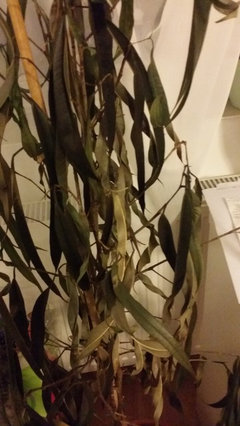

Dave
7 years agolast modified: 7 years agoAll the leaves are dead.
Scratch the bark with your findernail to see if it's green underneath. That would mean the tree is still alive.
Most of the roots have probably rotted at this point. It looks to have been severely overwatered.
Plants that are overwatered react the same as if they weren't watered at all. The roots rot and no longer function, the leaves then shrivel and die.
You only water when the soil is dry. Not just dry on the top, but you must let it dry out some between waterings.
im not sure if there is any hope for this tree giving the conditions.
If it was still viable it might be saved, but it's going to take a lot of work and learning on your end, if you're up for it.
Cristina Belu
7 years agoThe main branch is green. But I have checked smaller ones and they are dry and brown. At this point should I change the soil? What do you think? I have placed the pot near the window. Thank you!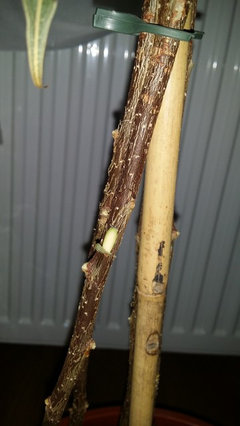
Dave
7 years agoYou can cut it back to the main stem and hope for the best.
Dont water at all until the soil is DRY.
Kathleen Schinkel
6 years agoHi! I bought a little baby ficus and planted it in a big pot. It was doing great! Loved the leaf patterns. Then I moved it upstairs to my garden. It was now in full sunlight, whereas before it was in partial sun. I water it daily like I always did. Yesterday I noticed the leaves turning brown. I read up and moved it to a less sunny place, took off the worst brown leaves, and am going to water it. I have enclosed pics. It looks
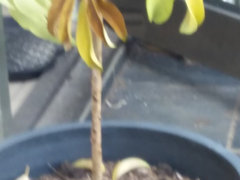
like it is slowly dying! Please help me!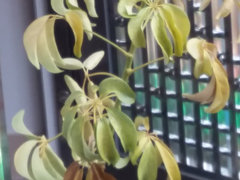
tapla (mid-Michigan, USDA z5b-6a)
6 years agoIt's a schefflera, but like ficus, it doesn't suffer wet feet well. It's very common to think that watering every day is the mark of an attentive care giver, but in the overwhelming % of cases, the overly attentive behavior ends up being extremely limiting to the plant. In some cases, with the right type of soil, you can water on a schedule and have healthy plants, but for the most part, plants should be watered on an 'as needed' basis instead of on any sort of schedule.
You might find this piece that offers A Basic Overview to be helpful ..... at least I hope you do.
Al
Kathleen Schinkel
6 years ago I came out this morning and this is how it looks. It is so much worse. It is not getting as much sunlight since I moved it. I am losing it. I watered thoroughly and have not since. There are no bugs at all. I cannot believe this. Should I put it in the afternoon sun??? Please help.
I came out this morning and this is how it looks. It is so much worse. It is not getting as much sunlight since I moved it. I am losing it. I watered thoroughly and have not since. There are no bugs at all. I cannot believe this. Should I put it in the afternoon sun??? Please help.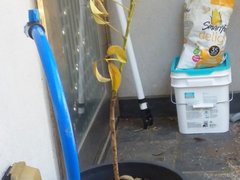
Kathleen Schinkel
6 years agoI just finished reading A basic Overview...I am very confused about fertilizer. Should I get some? What type? Percentage??Thank you!
tapla (mid-Michigan, USDA z5b-6a)
6 years agoWhat kind of soil is it in?
Virtually all containerized houseplants need regular nutritional supplementation; so YES, you should have a good fertilizer on hand and have a strategy in place that includes regular fertilizing that is adjusted in relation to the changes in growth habit as the plant makes it's way through the growth cycle. No one can tell you how to fertilize w/o knowing something about your soil and your watering habits, because those factors determine how much you use and how often you use it.
If I guessed you were just getting interested in learning how to best provide for your plants' cultural needs, would I be right? In most cases, the manner in which a person addresses the issues for which you seek guidance will depend on your level of experience.
I use, as do many others, and highly recommend Dyna-Gro's Foliage-Pro 9-3-6 fertilizer. There are a number of reasons for this, and I can direct you to a thread that lays out those reasons if you have interest. Your plant probably shouldn't be fertilized until you see signs of new growth. My guess is, the soil has been kept overly wet, which accounts for a very high % of the problems for which folks eventually arrive here in search of resolution. Once all the leaves fall, the amount of water your plant uses will be minuscule, so make sure you do not over-water. If you don't know how to use a wooden dowel/skewer as a tell, and want to, just ask. Many folks here use or have used that method with good results. It doesn't lie and will tell you when your plant does/doesn't need water.
Al
martha_richardson5138
6 years agoI have a weeping ficus that was left outside, and the cold killed the leaves, the plant is well establish, do you think it has a chance to re foliage?
Dave
6 years agolast modified: 6 years agoIt depends.
Scratch the bark with your finger nail and see if it’s still green and viable underneath. If so, prune off any dead, keep it in a warm bright location and give very little water. Just enough so it doesn’t dry out completely.
that is, if it’s potted.
photos would greatly well. We can’t see what you see.






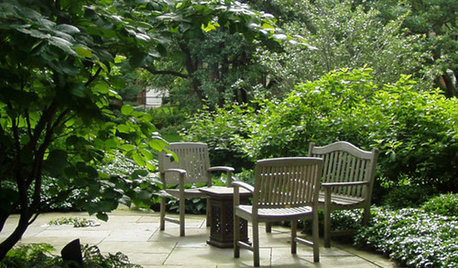









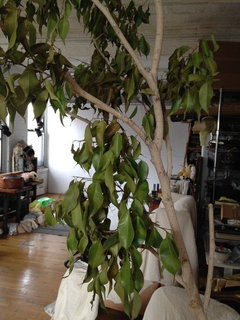


HU-967302259